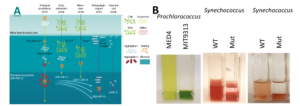Project highlights
- Uncover the “genetic dark matter” responsible for maintaining buoyancy in marine phytoplankton
- Test how abiotic and biotic stress impact buoyancy traits of marine phytoplankton
- Translate discoveries of buoyancy traits into an better understanding of the Earth’s carbon cycle through the biological pump
Overview
Industrialisation has short-circuited the Earth’s carbon cycle; converting ~0.4 trillion tons of organic carbon back to CO2 from the burning of fossil fuels. The most rapidly cycled pool of carbon is in the Oceans. In the surface oceans, single celled microbes convert CO2 to particulate organic carbon (POC) through photosynthesis. POC can sink into the ocean interior, through the activity of the biological carbon pump (BCP), effectively storing it for hundreds of years (Figure 1A). Without the BCP, the predicted atmospheric CO2 concentration would be doubled.
We currently have a poor understanding of the processes that determine the strength of the BCP However, it is thought that buoyancy traits of surface marine phytoplankton plays a key role [1]. These organisms face a consistent challenge to fight the BCP and maintain themselves in the upper surface ocean, where light can drive photosynthesis. Meanwhile, many biotic and abiotic stresses act upon phytoplankton to force them downward. We have evidence that the propensity to combat the activity of the BCP is genetically encoded (Figure 1B). This project will seek to unravel the genetic mechanisms that phytoplankton employ to fight the BCP and understand how external stresses can overpower these mechanisms. You will combine cutting-edge high-throughput genetics with whole genome sequencing to identify genes required for buoyancy in model marine phytoplankton. You will then validate these genes by standard genetic manipulation and test the effect of a range of abiotic and biotic stressors on these mutants. Your data will have strong implications for our understanding of the Earth’s carbon cycle.
Figure 1: (a) Schematic of the biological carbon pump (Taken from [2]). (b) Examples of novel buoyancy traits in marine cyanobacteria Prochlorococcus and Synechococcus. The genetic basis for these buoyancy traits are unknown.
Host
University of WarwickTheme
- Climate and Environmental Sustainability
- Organisms and Ecosystems
Supervisors
Project investigator
- Richard Puxty (University of Warwick, [email protected])
Co-investigators
- Prof. David Scanlan (University of Warwick, [email protected]).
How to apply
- Each host has a slightly different application process.
Find out how to apply for this studentship. - All applications must include the CENTA application form. Choose your application route
Methodology
You will use a combination of cutting-edge high-throughput genetics [3] and laboratory evolution experiments [4] to screen for novel buoyancy traits in model phytoplankton. You will then validate these mutants by standard genetic manipulation as established in the supervisor’s laboratories [5]. Characterisation of mutants will involve combinations of transcriptomic and proteomics. Together you will become expert in microbiology, microbial genetics, molecular cloning and next generation sequencing.
Training and skills
Training will be provided in the above techniques that have been developed in the Puxty and Scanlan labs. Many of these techniques will involve transferable technical skills including use of robotics and genetic manipulation.
DRs will be awarded CENTA Training Credits (CTCs) for participation in CENTA-provided and ‘free choice’ external training. One CTC can be earned per 3 hours training, and DRs must accrue 100 CTCs across the three and a half years of their PhD.
Partners and collaboration
The supervisors are world-leading experts in marine molecular biology. We frequently publish in high profile interdisciplinary journals (e.g. Nature Plants, Current Biology, Proc. Natl. Acad. Sci. USA) and field specific high impact journals (e.g. The ISME Journal). You will belong to a larger group of environmental microbiologists in the department of life sciences’ environment theme. These groups occupy a large shared lab area and as such there is continuous collaborations and opportunities for career development within the theme. Current research in the groups is funded by NERC and generous start-up award to Dr. Puxty.
Dr Puxty’s group: https://warwick.ac.uk/fac/sci/lifesci/people/rpuxty/
Prof Scanlan’s group http://www2.warwick.ac.uk/fac/sci/lifesci/people/dscanlan
Further details
Informal enquiries can be made to Dr Richard Puxty ([email protected]).
To apply to this project:
- You must include a CENTA studentship application form, downloadable from: CENTA Studentship Application Form 2025.
- You must include a CV with the names of at least two referees (preferably three) who can comment on your academic abilities.
- Please submit your application and complete the host institution application process via: https://warwick.ac.uk/fac/sci/lifesci/study/pgr/studentships/nerccenta/ University of Warwick projects will be added here: https://warwick.ac.uk/fac/sci/lifesci/study/pgr/studentships/nerccenta/studentships/ and application guidance is at the bottom of this page. Complete the online application form – selecting course code P-C1PB (Life Sciences PhD); from here you will be taken through to another screen where you can select your desired project. Please enter “NERC studentship” in the Finance section and add Nikki Glover, [email protected] as the scholarship contact. Please also complete the CENTA Studentship Application Form 2025 and submit via email to [email protected]. Please quote CENTA 2025-W17 when completing the application form.
Applications must be submitted by 23:59 GMT on Wednesday 8th January 2025.
Possible timeline
Year 1
Perform high-throughput genetic screen to identify gene candidates required for buoyancy in model marine phytoplankton.
Year 2
Verify these gene candidates by classical reverse genetics.
Year 3
Test the affects abiotic and biotic stresses on capacity for buoyancy in wild type cells and mutants lacking buoyancy genes.
Further reading
[1] Guidi, L et al., 2016. Plankton networks driving carbon export in the oligotrophic ocean. Nature, 532, 465-470.
[2] Boyd, P.W., Hervé, C., Levy, M., Siegel, D.A, Weber, T., 2019. Multi-faceted particle pumps drive carbon sequestration in the ocean. Nature, 568, 327-335.
[3] van Opijnen and Camilli, A., 2013. Transposon insertion sequencing: a new tool for systems-level analysis of microorganisms. Nature Reviews Microbiology 11, 435–442.
[4] Rainey, P and Travisano, M. 1998. Adaptive radiation in a heterogeneous environment. Nature, 394 69-72.
[5] Ostrowski et al. 2010. PtrA is required for coordinate regulation of gene expression during phosphate stress in a marine Synechococcus. ISME J., 4, 908-921.

